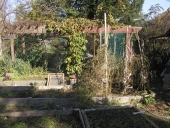Here is some info about growing goji seeds from the goji berries which you may have on hand. This is instructions on how to make juice, but near the end they explain how to use the seeds afterwards to grow goji bushes:
Our customers are always asking us, "Which is better, Goji juice or Goji berries?"
You've probably seen all the ads on the internet for Goji juice. Have you also noticed how expensive it is?
When you buy pre-made Goji juice, you don't really know what's in it. Making your own is not hard, and when you do, you know exactly what it's made of.
Some people have digestive issues that make it easier to assimilate juice than to eat the berries. The following method works especially well for them.
Sometimes we make our own juice by soaking the berries overnight. We suggest drinking it in the morning. Be careful though, because it's quite potent. It gives you lots of energy. If you drink too much you might have trouble sleeping the following night. Don't say I didn't warn you!
If you don't drink it all at once, be sure to refrigerate what's left. Otherwise you'll end up with fermented Goji "beer!"
Here's how you Make Your Own Goji Juice in your very own 12 Step program:
1. Put about 4 ounces of Goji berries in a 16 ounce drinking glass
2. Just barely cover them with pure water
3. Soak and refrigerate them overnight
4. Put the soaked berries in the blender
5. Add just enough water to get them to blend
6. Blend them until pureed, about 1-2 minutes
7. Place a coffee filter into a coffee filter holder sitting in a large measuring cup or small bowl
8. Pour the puree into the coffee filter
9. After about 2 hours, the Goji juice has filtered through
10. Add additional water now and again to "wash" more juice out until all the flavor is out of the pulp
11. You can mix the pure Goji Juice with other juices if desired
12. Drink to your health. We mean it!
What do you do with the pulp? Throw it out or feed it to the chipmunks. However,
if you want to try a fun experiment, put a layer of potting soil in a planting tray, spread all the pulp all over the soil, put another layer of soil on top, and keep it moist and warm. After about 2 weeks you'll start to see lots of little sprouts coming up. Goji seems to be a slow growing plant, but soon you'll have a thick, beautiful carpet of Goji sprouts. After they sprout, give them some sun. Got this here:
http://forgojiberries.com/ scroll down and look for the section called: How To Make Your Own Goji Juice









